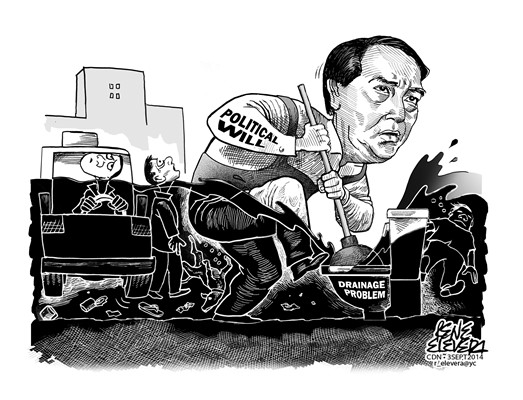Last Thursday’s street flooding was another scene of the same problem Metro Cebu has been experiencing over the years as the pace of urbanization outstrips our common sense.
In the past five years, as storms intensify and even when rainfall is a seasonal occurence, flooding has gotten worse.
Blame nature? Curse the fact that half of the year is the rainy season with monsoons?
Look again at the excess of man, rather than water.
Drainage outlets disappeared as buildings rose. Open spaces were covered with concrete. Settlements occupied what used to be natural passages of rain water.
Trash is a never-ending stream of plastic and styrofoam tossed on a road or waterway.
Urban flooding is a perversion of the gift of rain from the sky. This is what happens when water has nowhere else to go.
The Mactan office of the state weather bureau Pagasa recorded 18.2 millimeters of rainwater in just one hour last Thursday.
For the whole day of Aug. 28, the volume of rain in Cebu was 61.1 millimeters. (According to Pag-asa, at 30 millimeters, low-lying areas will go under water, which is what happened on a working day past 4 p.m. after just two hours of a downpour.)
This wouldn’t happen, though, if cities of Cebu, Mandaue and Lapu-Lapu had an adequate sewage system.
There’s no such thing. What the metropolis has is a patchwork of canals, culverts, and rivers so silted and clogged, we call them creeks.
A few months back, the Metropolitan Cebu Water District was appealing to customers to go easy on water consumption and to save, save, save on water because an El Niño dry spell is predicted later in the year.
To ease the pressure on the aquifer, pumping stations even cut back, prompting a wave of complaints of low pressure or no service in some areas as summer ended.
Now that we have water, a deluge from the sky, we curse its presence.
We are told that one millimeter of rain is equivalent to 5,000 barrels of water poured in a one square kilometer area.
How quickly the resource turns from a commodity in great demand – for drinking, bathing, swimming pools and high-volume laundry for Cebu’s growing tourism accommodations – into an unwanted surplus.
Why can’t the rain that ends up in knee-deep floods be channeled into a reservoir for sustaining life?
Why should runoff from the mountains end up in the sewers, washing away topsoil and destroying subdivisions?
If Metro Cebu is to find its way to sustainable growth, residents and policymakers have to wrestle with its priorities.
We need new eyes to see the rain as a precious resource, one that we have sadly been wasting and now look at with fear.
Disclaimer: The comments uploaded on this site do not necessarily represent or reflect the views of management and owner of Cebudailynews. We reserve the right to exclude comments that we deem to be inconsistent with our editorial standards.





